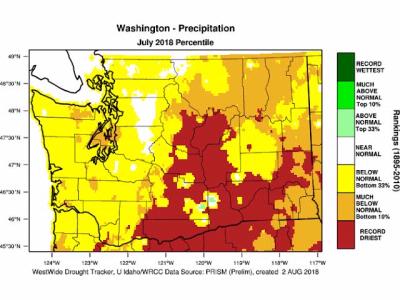
Watching the water supply
Friday, August 03, 2018
 |
Our friends across the state fighting fires know how dry this spring and summer has been - and indeed 70 percent of the state is abnormally dry, according to the U.S. Drought Monitor. So it's natural that by the first week of August we'd see this dry weather having some impact on water supplies as a result. The driest areas include those counties bordering the lower Columbia River in Southwest Washington. Some communities there and on the Olympic Peninsula are calling for water conservation. And hot weather has warmed some river temperatures to conditions mimicking the waters off Hawaiian beaches -- that means salmon there will be waiting for cooler waters before migrating up stream. Western Washington Christmas tree growers are turning to irrigation due to dry conditions. Wildfires and hot weather notwithstanding, we thankfully aren't expecting an official water supply drought emergency to be declared. It's been hot and dry, but water supplies so far haven't met that threshold. While the federal Drought Monitor is one of the tools we use to assess water supply conditions, in Washington state a drought emergency is defined under state law. It is a two-prong test: Official drought declarations provide us flexibility to authorize emergency wells and water withdrawals. Let’s look at some stats for the month of July and consider what the forecast might hold. July temperatures were above normal for most of the state, with the exception of areas in Northeastern Washington. Bellingham had its fourth warmest July in the past 67 years. In Seattle, temperatures were the second warmest on record. Olympia ranked seventh this July, and Walla Walla the tenth warmest. The next few days bring some cooling relief with a return to warmer temperatures in the second week of August. The longer-term picture continues to predict warmer weather for the remainder of summer Extended dry conditions, coupled with a rapid snowmelt, have resulted in below-normal flows for nearly 50 percent of the state's rivers and streams. (Below normal is defined as less than the 25th percentile.) These low flows are particularly prevalent on lower-elevation, rain-dominant streams. On larger rivers, especially where flows are being supplemented by reservoir releases, conditions tend to be better. In the lower Yakima River, warm water temperatures have created a “thermal block” to the upstream migration of sockeye salmon, according to the Department of Fish and Wildlife. Temperatures measured in the Yakima River near Prosser have often exceeded 80 degrees during the month of July.
· An area has or is expect to receive is 75 percent or less of normal supplies AND
· Undue hardships are likely to occur as a result.
High temps along with no rain
Some portions of Western Washington will receive light precipitation in early August, but Washington still has a big water hole to fill.
SeaTac only received 0.05 inches of rain In July (normal is 0.70 inches). That ranks as the sixth driest July in the past 71 years. Hoquiam did not fare much better at 0.06 inches, the fifth driest in the past 64 years. The town of Ephrata in Eastern Washington received no rain at all. That has only occurred 16 out of the past 70 years. Precipitation deficits in the southwest corner of the state, which have accrued since early May, are unlikely to disappear before the end of the current water year (Sept. 30), though it’s still possible.
Lack of precipitation requires growers to compensate with additional irrigation of crops. The state Conservation Commission has received reports of kills of Christmas tree seedlings and of trees dropping their needles. Conservation Districts are receiving requests from tree growers for irrigation assistance, where irrigation was not needed previously. Hay growers are experiencing large reductions in yield in their second cutting of hay.
?The longer-term climate outlook (August through October) calls for equal chances of above- or below-normal precipitation in Eastern Washington. For Western Washington, the odds tip toward drier conditions. Streamflows
Salmon impacts
Temps in the South Fork Chehalis River hit 80.7 degrees on July 29.
Temperatures above 73-77 degrees are considered lethal.
Of the 30 warmest mean daily water temperatures recorded since 1990 at the Prosser station, 12 occurred this July. Biologists say that salmon will likely stay in the Columbia River until the Yakima River cools down.